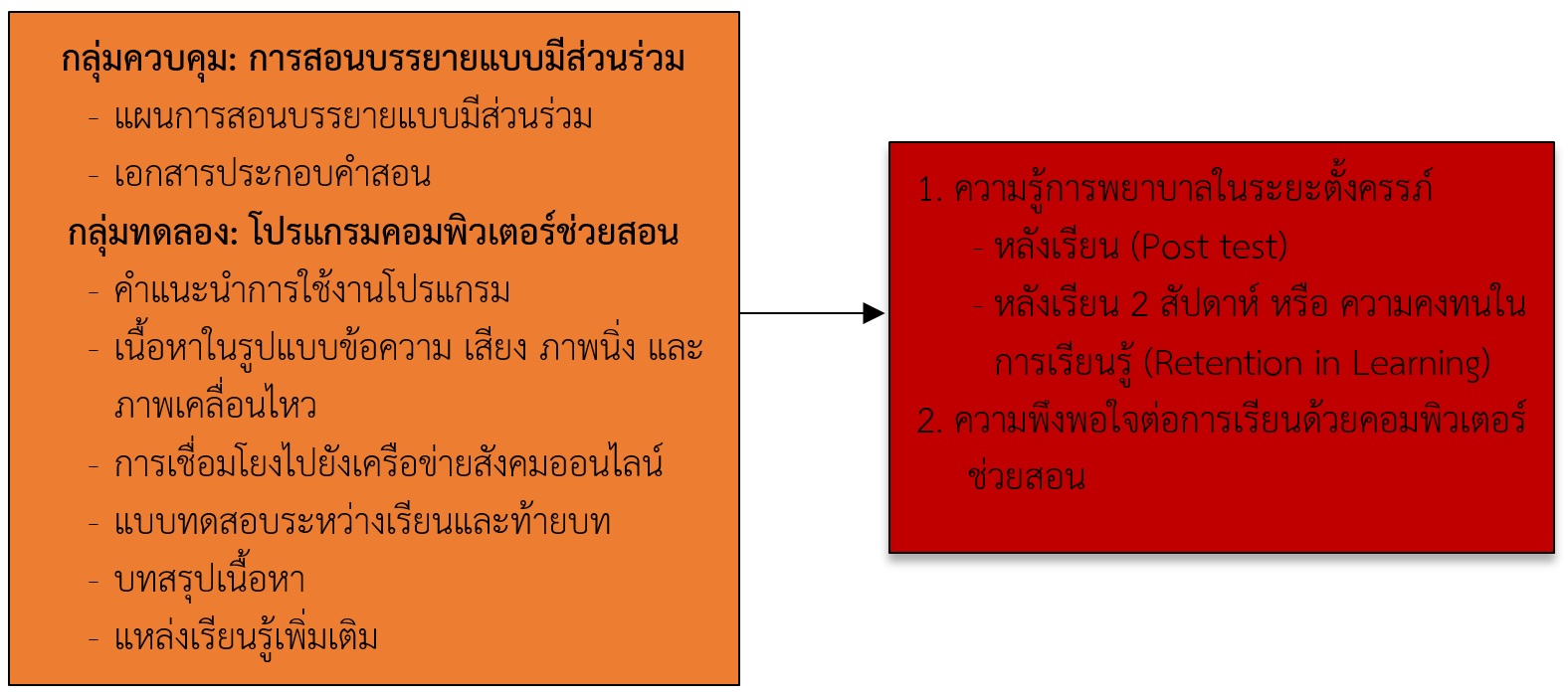เปรียบเทียบผลของวิธีสอนระหว่างการใช้โปรแกรมคอมพิวเตอร์ช่วยสอน กับวิธีสอนแบบปกติต่อความรู้การพยาบาลในระยะตั้งครรภ์ และความพึงพอใจของนักศึกษาพยาบาล
คำสำคัญ:
โปรแกรมคอมพิวเตอร์ช่วยสอน, วิธีสอนแบบปกติ, ความรู้การพยาบาลในระยะตั้งครรภ์, ความพึงพอใจของนักศึกษาพยาบาลบทคัดย่อ
การวิจัยกึ่งทดลองนี้เพื่อเปรียบเทียบผลการสอนด้วยคอมพิวเตอร์ช่วยสอนและวิธีสอนปกติต่อความรู้การพยาบาลในระยะตั้งครรภ์ระหว่างก่อนเรียน หลังเรียน และ 2 สัปดาห์ หลังเรียน (ความคงทนในการเรียนรู้) และความพึงพอใจต่อการเรียนด้วยคอมพิวเตอร์ช่วยสอน กลุ่มตัวอย่าง คือ นักศึกษาพยาบาลศาสตรบัณฑิต ชั้นปีที่ 2 วิทยาลัยพยาบาลบรมราชชนนี นครราชสีมา ปีการศึกษา 2562 คำนวณตัวอย่างด้วยโปรแกรม G*POWER ได้จำนวน 46 คน สุ่มตัวอย่างด้วยวิธีการจับฉลากแบบไม่ใส่คืน เครื่องมือวิจัยกลุ่มทดลอง ได้แก่ โปรแกรมคอมพิวเตอร์ช่วยสอนมีค่า IOC อยู่ระหว่าง .67-1.00 และแบบประเมินความพึงพอใจต่อการเรียนด้วยคอมพิวเตอร์ช่วยสอนมีค่า CVI เท่ากับ .98 เครื่องมือวิจัยกลุ่มควบคุม ได้แก่ แผนการสอนบรรยายแบบมีส่วนร่วมมีค่า IOC อยู่ระหว่าง .67-1.00 ทดสอบความรู้การพยาบาลในระยะตั้งครรภ์ก่อนเรียน หลังเรียน และ ความคงทนในการเรียนรู้ทั้ง 2 กลุ่มด้วยข้อสอบปรนัย ซึ่งมีค่าความเชื่อมั่น KR-21 เท่ากับ .77 วิเคราะห์ข้อมูลโดยสถิติทดสอบค่าที Paired Sample t- test และ Independent Sample t- test ผลการวิจัยพบว่า
กลุ่มทดลองมีค่าเฉลี่ยความรู้หลังเรียน (M=15.65, SD=1.61) สูงกว่ากลุ่มควบคุม (M=13.96, SD=1.39) ความคงทนในการเรียนรู้ของกลุ่มทดลอง (M=15.83, SD=1.46) สูงกว่ากลุ่มควบคุม (M=14.26, SD=1.42) อย่างมีนัยสำคัญทางสถิติที่ระดับ .001 ความพึงพอใจต่อการเรียนด้วยโปรแกรมคอมพิวเตอร์ช่วยสอนอยู่ในระดับมาก (M=4.31, SD=.61)
ผลการวิจัยครั้งนี้สามารถนำโปรแกรมคอมพิวเตอร์ช่วยสอนไปเป็นแหล่งศึกษาค้นคว้าด้วยตนเองสำหรับนักศึกษาพยาบาล ซึ่งช่วยพัฒนาผลสัมฤทธิ์ทางการเรียนของนักศึกษาพยาบาล และเป็นแนวทางในพัฒนาสื่อการสอนในรูปแบบอื่น ๆ เช่น แอปพลิเคชัน หนังสืออิเล็กทรอนิกส์ เพื่อตอบสนองความต้องการของผู้เรียนในศตวรรษที่ 21
References
Bhothidara, Y. (2011). Nursing Education Management: For Student Generation Y. Journal of Nursing Science and Health, 34(2), 61-69. (in Thai)
Bloom, B. S. (1971). Handbook on Formative and Summative Evaluation of Student Learning. New York: McGraw-Hill.
Boromarajonani College of Nursing, Nakhon Ratchasima. (2017). Bachelor of Nursing Science Program (Update course of B.E. 2560 (2017). n.p. Boromarajonani College of Nursing, Nakhon Ratchasima. (in Thai)
Buranasak, J., Limruangrong, P., & Pungbangkadee, R. (2014). The Effect of Computer Assisted Instruction Assisted Instruction of Abdominal Examination on Knowledge, Abdominal Examination Skills and Satisfaction of Nursing Students. Journal of The Royal Thai Army Nurses, 15(3), 361-370. (in Thai)
Chaimanee, T., Dissathaporn, C., Rojsomrith, W., & Onming, R. (2017). The Efficiency of Computer Based Simulation via Internet on Practice Guidelines Prevention of Nosocomial Infection for Nursing Students. Academic Service Journal Prince of Songkla University, 28(1), 130-142. (in Thai)
Cohen, J. (1992). Quantitative Methods in Psychology: A Power Primer. Psychol Bull, 112(1), 155-9.
Detamma, S., & Insombat, B. (2017). The Effects of Using Computer-Assisted Instruction in the Topic of Information and Communication Technology on Learning Achievement and Learning Retention of Mathayomsuksa 2 Students. Social Sciences Research and Academic Journal, 12(36), 83-96. (in Thai)
Erb-Arb, S. & Leevirat, S. (2014). Effect of Computer-Assisted Instruction for Aerosal Administration Therapy in Children on Nurses, Knowledge and Medication Management Skill and on Children’s Respiratory Response. Journal of Journal of The Royal Thai Army Nurse, 21(3), 275-282. (in Thai)
Grove, S. K., Burns, N. & Gray, J.R. (2013). The Practice of Nursing Research: Appraisal, Synthesis and Generation of Evidence. (7th ed.). St. Louis, Missouri: Saunders Elsevier.
Jirawatkul, A. (2020). Comparison of Knowledge Scores Between Groups. Journal of Health Science. 22(9), 189-190. (in Thai)
Keller, J. M. (2006). Keller’s ARCS Model of Motivational Design. Retrieved June 21, 2019 from: http//www.arcsmodel.com
Klunkhajhon, S., Rithpho, P., Boonpracom, R., & Pienjing, K. (2015). Development of Computer Assisted Instruction: Regarding the Breastfeeding. Journal of Nursing and Health Sciences, 9(1), 67-82. (in Thai)
Kowtrakul, S. (2013). Educational Psychology. (11th ed.). Bangkok: Chulalongkorn University. (In Thai)
Malithong, K. (2005). Educational Technology and Innovation. Bangkok: Aroonkarnpim. (In Thai)
Ma-oon, R. (2016). Effective Teaching and Learning in Graduate Education. Journal of Southern Technology, 9(2), 169-174. (in Thai)
National Education Act of B.E. 2542 (1999) and Amendment (Second National Education Act. B.E. 2545 (2002). (2002). National Education Act. Retrieved July 21, 2019 from: https://person.mwit.ac.th/01Statutes/NationalEducation.pdf. (in Thai)
Pakdeto, R., Sawadipanich, N. & Suntiti, R. (2013). Effect of A Computer Assisted Instruction Nursing Care of Children with Intravenous Fluid Therapy Toward knowledge. Journal of Boromarajonani College of Nursing, Bangkok, 29(1), 110-120. (in Thai)
Punyoo, J., Saehoong, S., Kongsaktrakul, C., Jongaramraung, J., srichalerm, T., & Wongdaeng, A. (2019). The Effect of Computer-Assisted Instruction of Pediatric Medication Administration on Medication Administration Skills among Nursing Students. Rama Nurs J, 25(2), 181-194. (in Thai)
Sanitlou, N., Sartpech, W. & Napha-arrak, Y. (2019). Sample Size Calculation Using G*POWER Program. SVIT Journal, 5(1), 498-507. (in Thai)
Srisatidnarakul, B. (2007). The Methodology in Nursing Research. (3rd ed.). Bangkok: Faculty of Nursing Chulalongkorn University. (in Thai)
Sukwiboon, T., (2009). Considerations for Creating a Rating Scale Tool for Research. Retrieved June 24, 2019 from: http://www.ms.src.ku.ac.th/scedule /files/2553/Oct/1217086.doc. (in Thai)
Tainchaiyapurk, P. (2016). The Role of the Teacher with the Student: Gen Y. Journal of MCU Socail Development, 1(1), 92-107. (In Thai)
Teerawatskul, S., Suttineam, U. & Buathongjun, J. (2017). Effect of Lecture on Nursing Care of Responses with Neurological Problem Developed by a Teacher and Online Computer on Knowledge, Learning Behavior, and Satisfaction of Nursing Students. Journal of Boromarajonani College of Nursing, Bangkok, 33(3), 101-111. (in Thai)
Wilailak, T. (2008). Lesson Design. Pathum Thani: Valaya Alongkorn Rajabhat University Under the Royal Patronage. (in Thai)

Downloads
เผยแพร่แล้ว
ฉบับ
บท
License
1. บทความหรือข้อคิดเห็นใด ๆ ที่ปรากฏในวารสารเครือข่าย วิทยาลัยพยาบาลและการสาธารณสุขภาคใต้ ที่เป็นวรรณกรรมของผู้เขียน บรรณาธิการหรือเครือข่ายวิทยาลัยพยาบาลและวิทยาลัยการสาธารณสุขภาคใต้ ไม่จำเป็นต้องเห็นด้วย
2. บทความที่ได้รับการตีพิมพ์ถือเป็นลิขสิทธิ์ของ วารสารเครือข่ายวิทยาลัยพยาบาลและการสาธารณสุขภาคใต้






